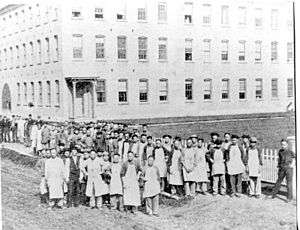North Adams strike
| North Adams strike | |||
|---|---|---|---|
 Men brought in to break the strike | |||
| Date | 1870 | ||
| Location |
North Adams, Massachusetts 42°42′7.44″N 73°6′49.97″W / 42.7020667°N 73.1138806°WCoordinates: 42°42′7.44″N 73°6′49.97″W / 42.7020667°N 73.1138806°W | ||
| Goals | Eight-hour day | ||
| Methods | Strikes, Protest, Demonstrations | ||
| Resulted in | Chinese immigrants brought in from California, replacing union workers for cheaper wages | ||
| Parties to the civil conflict | |||
| |||
| Lead figures | |||
| |||
| Arrests | |||
| |||
The North Adams strike was a strike in 1870 by shoe workers of the Order of the Knights of St. Crispin, against Calvin T. Sampson's Shoe factory, in North Adams, Massachusetts. The strike itself was broken when Sampson imported seventy-five unskilled male Chinese strikebreakers, from California.
Legacy
The craft union itself was eventually defeated by mechanization, although a decade later only five immigrants remained in North Adams. Those that did move out eventually moved to Boston to found their Chinatown. The United States passed the Chinese Exclusion Act in 1882, further restricting immigration to the country and continuing the gender imbalance that started with the laborers for many years to come.[1][2][3]
References
- ↑ "On This Day..." Mass Moments. Retrieved 18 November 2015.
- ↑ "A Study of the North Adams Labor Strike, 1870". Inquiry Unlimited. Retrieved 18 November 2015.
- ↑ Gyory, Andrew. "A Shoemaker's Story". Picturing U.S. History. Retrieved 18 November 2015.
Sources
- Anthony W. Lee (2008). A Shoemaker's Story: Being Chiefly about French Canadian Immigrants, Enterprising Photographers, Rascal Yankees, and Chinese Cobblers in a Nineteenth-Century Factory Town. Princeton University Press. ISBN 9780691133256.
This article is issued from
Wikipedia.
The text is licensed under Creative Commons - Attribution - Sharealike.
Additional terms may apply for the media files.